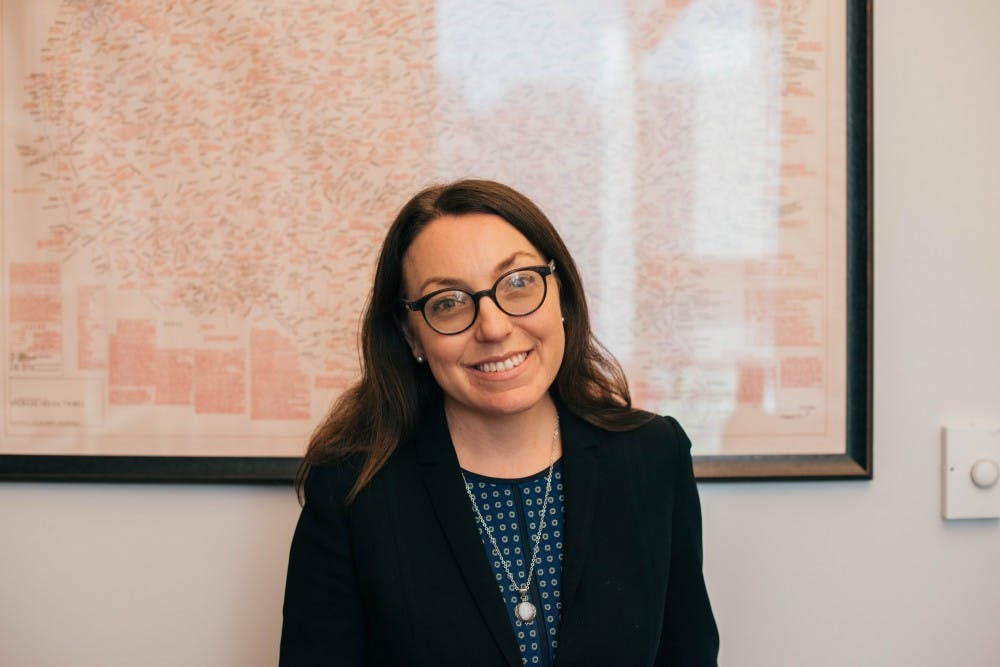“It feels as though you are carving completely new ground,” I remark to Professor Maggie Blackhawk, a Federal Indian Law scholar at the University of Pennsylvania Law School and a member of the Fond du la Band of Lake Superior Ojibwe. She responds with a quick burst of friendly laughter before responding, “I have been told that by others before.”
It is an incredibly modest answer for one of the two Federal Indian Law scholars at the Law School, who recently published a 100–page Harvard Law Review article, an op–ed in the New York Times, and acts as the Senior Constitutional Advisor to the President of the Minnesota Chippewa Tribe.
The aforementioned articles are her newest contributions to the field, and they're accompanied by many other publications and conferences, but they all forward the same thesis: that “we have not yet reformed the laws that allowed for the abuse of Native Americans,” because we have not “d[ug] deep into the field and the way that their doctrine and law may have a connection to American colonialism.”
She points to the case, United States v. Rogers (1846), a standing that still exists today, which upheld that “aboriginal tribes of the Indians in North America are not regarded as the owners of the territories which they respectively occupied.”
On–the–ground activism regarding indigenous rights made headlines during the I Stand with Standing Rock (Also known as: “NO DAPL”) movement in North Dakota in 2017. Further, calls to change the Washington Redskins football team name, and a New York Times article about the discourse surrounding Massachusetts' official state seal (which depicts a Sword hanging over a Native American) show a shift in the right direction.
It was legal activism that originally inspired Professor Blackhawk to attend law school, after working with “a team of women lawyers, who were lobbyists, working to change the legislation.” She notes that “it’s been Congress, not the courts, that’s been saving Indian Country.”
But, Professor Blackhawk is not going into Congress, at least anytime soon, instead she has decided to go into the legal academy, because “[she] thought that we could try and help the other branches, as well as scholars, in training lawyers differently.” She continues that, “I realized from that course, and publishing my own work shortly after, that I could do more for Indian country by going into the legal academy, rather than just litigating, because there was little exposure for future lawyers to have a framework, and law schools train these future leaders.”

Now, it is her goal as a professor to, “train the best lawyers I can. The law is a tool—and a really amazing one—so my hope is to train the best lawyers but also, through my work and action, to have our students leave here with a better understanding of the value of pluralism, diversity, and the reality of what our country has been: to celebrate the good and see the bad. And to base their norms and morals on those—to go into the legal world with eyes wide open.”
Professor Blackhawk's room is filled with law books, thoroughly highlighted and opened on her desk. It's clear how importantly she views her work, and how she integrates it into her daily life. The walls are filled with famous indigenous paintings. Right between where the bookshelf and ceiling meet, there are eight license plates. On the other side of the room, there is a seemingly familiar United States map, but instead of an emphasis on the state lines, the map is marked with native countries.
“It’s a way of responding to erasure,” she explains, “these famous painters, and the map where the landscape is all devoid.” Instead, it is the native countries at the focal point, as a “way to claim that land.”
Characteristically, her eyebrows furrowed together in thought before her face returns to her smile, “sovereignty can look like a license plate, native government issues license plates for those cars, it’s a quick way of showing students that these governments are governing and doing wonderful things, just like other governments.”
Looking forward, Professor Blackhawk is attentive to future legal battles. For example, Carpenter v. Murphy is a case that was heard before the Supreme Court this past session, but was ultimately put onto the next semester—an uncommon move. The case asks the question: Do the 1866 territorial boundaries of the Creek Nation within the former Indian Territory of eastern Oklahoma constitute an “indian reservation” today under the “Indian country definitions” within the law?
Professor Blackhawk’s work is new, and when asked about her limitations in the field, she states “because it is so new, there has been a wonderful response. Many scholars have started the conversation to, at the very least, change the classes to be teaching students about Native nations and American colonialism in their classes. I’ve had a few scholars reach out to me, and tell me it’s not only about including the [Harvard Law Review] article in their class, but about how to shift the paradigm.”
We can look towards Professor Blackhawk as an inspiration to stand up for the voices silenced. We can look at her as an inspiration that shows the true power that laws can have. But, perhaps most importantly, we can thank her for carving out a new territory in the legal field.







